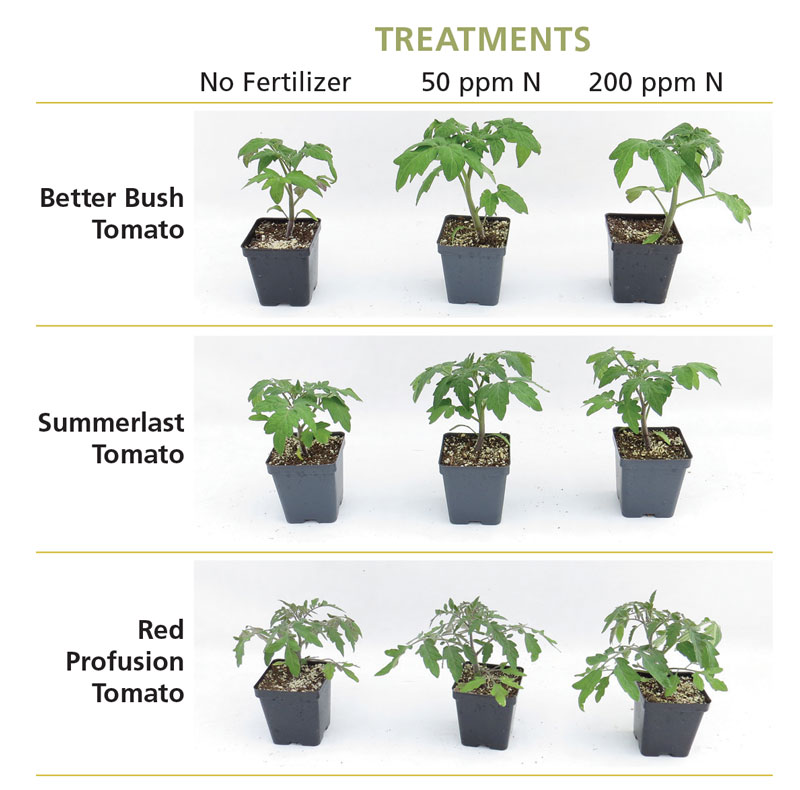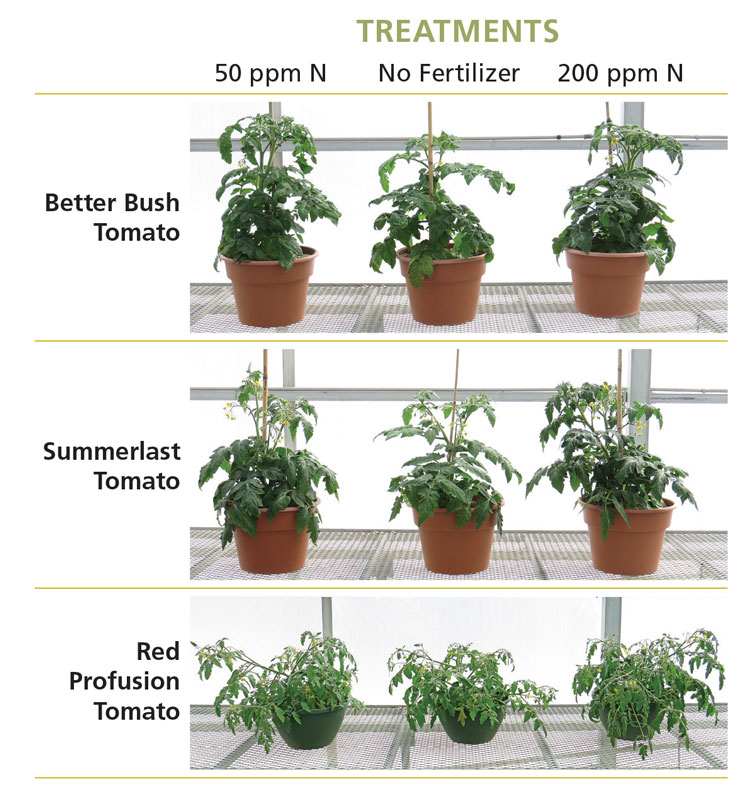9/1/2020
Vegetable Fertility Basics for Flower Growers
Dr. Alicain S. Carlson, Dr. Yanjun “Cecilia” Guo & Jeannine R. Bogard
Vegetable transplants have been the fastest-growing category for retailers this past season. It’s estimated that nearly 30% of grow-your-own consumers are growing vegetables for the first time, and a good portion of these may decide they enjoy the garden-to-fork experience and will continue to vegetable garden into the future.
To meet growing demand for vegetables we anticipate there’ll be bedding plant growers entering this category for the first time. With vegetables, the key to consumer success and repeat sales is building a strong plant structure that will support the fruit load later in the season. This starts at the beginning of the growing cycle with fertility and nutrition, which can have the greatest impact on plant quality for both the grower and consumer.
What can go wrong?
With ornamental production, oftentimes feed and plant growth regulators (PGRs) are utilized to control the plant during production. This strategy is counter-productive with vegetable culture, and PGRs labeled for vegetable production are limited, so it’s important to control plant growth with cultural practices.
Cultural practices to use on vegetable crops to control height include: 1) Limiting excess nitrogen and using the correct form; 2) targeting the proper balance of N-P-K in your fertilizer regime (vegetable crops usually don’t need the additional phosphorus that are contained in most flower feeds); and 3) reducing irrigation frequency. Manipulating environmental conditions and periodic brushing of the plants with a soft-ended pole or continual, mild bench vibration to disrupt stem growth can also help control height without chemistries. (Of course, these practices can also apply to ornamental production to control growth.) But a practice of focus in this article is utilizing the proper fertilizer regime.
 One of the biggest undesirable consequences of improper fertilization of vegetable crops is stretched, weak growth that’s ultimately unable to support the fruit load the consumer expects from today’s high-yielding varieties. From a grower standpoint, taller plants mean fewer shelves on a rack; weak plants that ship poorly mean the likelihood of shrink is higher due to losses from breakage and disease. If it makes it to the consumer, it could turn into a poor garden experience when their tomato plants crumble under the pressure of 30-plus pounds of fruit.
One of the biggest undesirable consequences of improper fertilization of vegetable crops is stretched, weak growth that’s ultimately unable to support the fruit load the consumer expects from today’s high-yielding varieties. From a grower standpoint, taller plants mean fewer shelves on a rack; weak plants that ship poorly mean the likelihood of shrink is higher due to losses from breakage and disease. If it makes it to the consumer, it could turn into a poor garden experience when their tomato plants crumble under the pressure of 30-plus pounds of fruit.
Other adverse consequences of overfertilization include: a reduction of flowering and therefore fruit production, higher insect and disease pressure, and an overabundance of certain nutrients could even lead to deficiencies of others. For growers wishing to produce a plant with fruit, excessive fertility will restrict or stall flower production, making fruit set challenging.
Figure 1. Effects of 50 vs. 200 ppm N of 20-10-20 fertilizer treatments compared to a control on three tomato varieties in 3.75-in. containers four weeks after the fertilizer treatments started. Note the excess height and foliage growth on the fertilizer treatments.
A fertility demonstration
We asked ourselves, “For growers not familiar with vegetable culture, what would happen if vegetables were produced with a flower fertilizer program?” In order to illustrate the negative effects on quality of using the wrong fertilizer, we designed a demonstration with two determinate tomato varieties (Better Bush and Summerlast), and one trailing tomato variety (Red Profusion) grown under three different fertilizer treatments.
We fertilized with 20-10-20 at 50 ppm N or 200 ppm N once per week and included a control group with no fertilizer, only the starter charge that was already in the root substrate. We started applying fertilizer treatments after transplant into 3.75-in. square containers for young plant evaluation. We then transplanted them into a 12-in. container and continued the treatments for a large container evaluation.
The plants were grown in a greenhouse in Gilroy, California, with daily light integral (DLI) of 10.5 mols/day and 14-hour photoperiod. Average air temperatures during the day was 66F (19C) with 57F (14C) during the night. We measured plant height, stem caliper and internode length, and counted the total number of internodes.
What we found
At the retail-ready stage in the smaller pots, the three tomato varieties were larger and taller under both fertilizer regimes compared to the control (Figure 1). Improperly fertilizing for even a short amount of time at this young plant stage had negative effects on quality by significantly increasing plant biomass and increasing the space the crops occupy during production and shipping. The crowding and foliage overlap during production could potentially increase disease pressure.
For the larger containers, the differences became more pronounced. Tomatoes grown under either fertilizer treatment had longer internodes and thinner stem calipers than the control plants (Figure 2). The internode lengths of the fertilized treatments were double and even triple that of the control plants. The stem caliper was 30% to 50% smaller than the control in the fertilized treatments.
 Figure 2. Effects of 50 vs. 200 ppm N of 20-10-20 fertilizer treatments compared to a control on three tomato varieties in 12-in. containers eight weeks after the fertilizer treatments started. Note the excess height and foliage growth on the fertilizer treatments. Extra height is from stretched, thin internodes making for weaker plants that may not be able to support future fruit load.
Figure 2. Effects of 50 vs. 200 ppm N of 20-10-20 fertilizer treatments compared to a control on three tomato varieties in 12-in. containers eight weeks after the fertilizer treatments started. Note the excess height and foliage growth on the fertilizer treatments. Extra height is from stretched, thin internodes making for weaker plants that may not be able to support future fruit load.
However, what all the plants had in common was the number of nodes regardless of treatment. This means the extra height in the improperly fertilized treatments wasn’t from faster growth and an increase in nodes—it was from stretched internodes. For the consumer, the extra stretch provides no benefit while reducing maximum stem strength and overall plant quality.
Take-home message
With vegetables, the growth strategy is to produce a strong plant built to support the future fruit load. For both growers and consumers, the highest quality and strongest plants are built from the very beginning. Don’t just throw your new vegetable program in with your flower fertilizer program; please consider vegetables’ unique needs and plan accordingly. This applies to pack/small pot/young transplant programs and cage/large container programs.
We recommend that vegetable programs are separated from ornamental production so that fertilization strategies can be differentiated. In this demonstration, we showed that a suboptimal fertilizer regime reduced overall plant quality and promoted stretched growth indicated by weak, thin stems and long internodes. What could be perceived as pushing the plant to bulk up to hit sales dates is actually reducing overall plant strength, resulting in the end consumer getting a less-than-optimal garden experience.
A properly fertilized vegetable program could help reduce production costs, allow more plants to ship on the rack, produce stronger plants with less tangling and reduce shrink. Most importantly, the home gardener will have the best experience and come back for more. GT
Alicain Carlson is the Technical Trial Manager, Yanjun Guo is a Technical Scientist, and Jeannine Bogard is the Home and Garden Vegetable Business Lead for Syngenta Flowers North America.